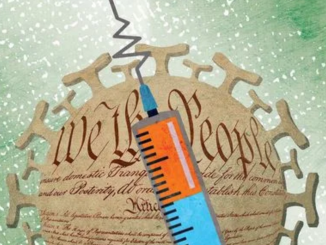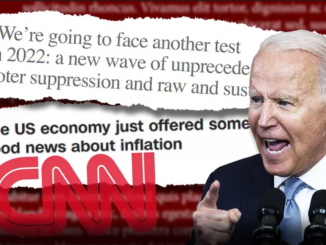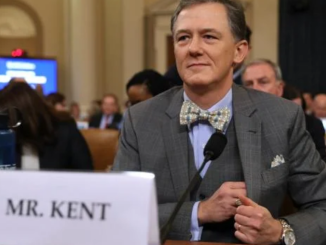
Dr. Anthony Fauci, the U.S. government’s top expert on COVID-19, was privately urged by former CDC Director Dr. Robert Redfield to vigorously investigate both the lab-leak and natural origins theories of virus in early 2020, only to then exclude Redfield from discussions with world-renowned virologists and wage a PR campaign denouncing the lab-leak theory as a conspiracy theory, according to an investigative report.
The explosive report from Vanity Fair reveals new details of how Fauci and former National Institutes of Health Director Dr. Francis Collins strongly pushed back against scientists who raised legitimate questions about the origins of the virus — questions that could implicate the NIH’s financial support for the non-governmental group EcoHealth Alliance and risky bat virus research in China.
By analyzing more than 100,000 internal EcoHealth documents, interviewing five former staff members, and speaking with 33 other sources, Vanity Fair’s Katherine Eban uncovered how EcoHealth Alliance operated in a world of “murky grant agreements, flimsy oversight, and the pursuit of government funds for scientific advancement, in part by pitching research of steeply escalating risk.”
Her report delves deep inside EcoHealth Alliance, showing how the group’s president, Peter Daszak, spent years wooing Fauci — at times literally at D.C. cocktail parties — to win federal support for gain-of-function studies at the Wuhan Institute of Virology, the Chinese lab central to the lab-leak hypothesis of COVID-19’s origins. Fauci, in turn, worked with Daszak, Collins, and other top virologists to lead a well-documented campaign discrediting the lab-leak theory, all the while never being completely transparent about their potential conflicts of interest should the theory prove true.
Under Fauci’s tenure at NIAID, EcoHealth Alliance received a $3.7 million federal grant in 2014 to study the potential for a deadly new coronavirus to emerge from wild bats in China. The group partnered with the Wuhan Institute of Virology, sub-awarding the lab $600,000 in federal funds, to collect virus samples from bats and analyze them.
In early 2020, the deadly COVID-19 pandemic would be traced back to a seafood market in Wuhan, China, near where the lab is located. Early analysis suggested that the SARS-CoV-2 virus was 96.2% similar to a previously discovered bat coronavirus, which led many scientists to believe the most likely origin for COVID-19 was that it hopped from bats to humans, possibly through an intermediary animal. However, an animal host for SARS-CoV-2 was never discovered. And unique features of the virus led some of the world’s top virologists, including those associated with Fauci, to raise the possibility that it was laboratory-engineered.
The fundamental questions concerning COVID-19 are whether EcoHealth Alliance paid for gain-of-function research at the Wuhan lab — experiments that make viruses deadlier and more infectious to humans — and whether Chinese scientists, either with federal funding from EcoHealth Alliance or on their own, engineered the SARS-CoV-2 virus before it somehow escaped the laboratory and caused a global pandemic, killing more than six million people.
After the pandemic began, U.S. Centers for Disease Control and Prevention Director Dr. Robert Redfield asked those questions.
“I personally felt it wasn’t biologically plausible that [SARS CoV-2] went from bats to humans through an [intermediate] animal and became one of the most infectious viruses to humans,” he told Vanity Fair.
As the Chinese government worked to cover up the spread of COVID-19 in late 2019 and through the new year, Trump administration officials desperately sought to learn how the pandemic started. Redfield was aware of a 2015 gain-of-function study funded by EcoHealth Alliance and published by Wuhan lab scientist Dr. Zhengli Shi with University of North Carolina virus expert Dr. Ralph Baric. The study had shown it was possible to manipulate a SARS-like bat coronavirus in a laboratory setting so that it would infect human cells, which researchers believed showed the danger that such a virus could naturally evolve to threaten humans.
The gain-of-function experiments were carried out in Baric’s laboratory in North Carolina, but the Chinese scientists had learned his techniques. Redfield questioned whether scientists in Wuhan had gone on to carry out gain-of-function experiments on their own, at a laboratory with insufficient security and little international oversight. Could that be where COVID-19 came from?
According to Vanity Fair, Redfield brought his concerns to Fauci in mid-January 2020. He also shared them with Jeremy Farrar, the director of the U.K. mega-charity Wellcome Trust, and Tedros Adhanom Ghebreyesus, director general of the World Health Organization (WHO). His message was: “We had to take the lab-leak hypothesis with extreme seriousness.”
What happened next is scandalous. A Freedom of Information Act request by BuzzFeed News revealed that on February 1, 2020, at 12:30 a.m., Fauci emailed NIAID principal deputy director Hugh Auchincloss a copy of the 2015 gain-of-function study and wrote, “Hugh: It is essential that we speak this AM. Keep your cell phone on.” He told Auchincloss to read the paper and wrote, “You will have tasks today that must be done.”
Later that day, Farrar organized a conference call with 11 top international virologists including Fauci and NIH Director Francis Collins to discuss what was known about the virus. Astonishingly, Redfield was excluded from the call. According to Vanity Fair, he was not even told it was happening. The person in charge of the agency leading the U.S. government’s response to the COVID-19 pandemic was kept out of discussions about the origins of the virus after asking Fauci and Farrar to seriously investigate all the possibilities.
The conference call was held “in total confidence,” and the details of the discussion remain shrouded in secrecy. What is known is that before the call, some of the participants, such as Dr. Kristian Andersen, a virologist at Scripps Research, had noted that some features of SARS-CoV-2 “(potentially) look engineered.” Andersen told Fauci in an email that several experts who had analyzed the virus “find the genome inconsistent with expectations from evolutionary theory.”
But after the call, those involved would condemn the lab-leak hypothesis and those advancing it. Within three days, four of the scientists who raised the possibility of a laboratory origin for COVID-19 signed on to a draft letter declaring that “we do not believe that any type of laboratory-based scenario is plausible.” That letter, titled, “The Proximal Origins of SARS-CoV-2,” was published in the journal Nature Medicine on March 17. National media outlets seized on the statement, inaccurately referring to it as a “study” that purportedly debunked the lab-leak theory.
Redfield, meanwhile, says he realized Fauci, Farrar, and the others had gone behind his back and launched a concerted effort to present the appearance of a scientific consensus that would shut down discussion of the lab-leak theory.
“They made a decision, almost a P.R. decision, that they were going to push one point of view only” he told Vanity Fair. “They argued they did it in defense of science, but it was antithetical to science.”
A spokesperson for the Wellcome Trust disputed that characterization. “The letter was a simple statement of solidarity with highly reputable researchers based in China and against non-evidence-based theories. Dr. Farrar does not believe the letter was covertly organized. He had no conflict of interest to declare,” the spokesperson told Vanity Fair.
Vanity Fair’s report recounts several details that have been previously reported by TheBlaze and others, such as Peter Daszak’s own campaign to organize scientists to denounce the lab-leak theory as a “conspiracy” and his effusive praise for Fauci’s public comments asserting the same. It paints a picture of Daszak as egotistical, gluttonous for federal funds to keep EcoHealth Alliance afloat, and naively trusting of his partners in communist China. He sought to “present the lab-leak hypothesis as a groundless and destructive conspiracy theory,” all the while never disclosing that were it true, his own organization would come under intense scrutiny for funding related, risky research at the Wuhan lab.
Yet even after unanswered questions and unlikely coincidences propelled the lab-leak theory into the mainstream, Fauci and Collins continued to play defense for Daszak and EcoHealth Alliance, in public and in private.
Vanity Fair describes in a revealing incident how the NIH officials were hostile to any suggestion by scientists that contradicted the natural origins narrative or placed suspicion on China.
In June 2021, an American scientist named Dr. Jesse Bloom discovered that Chinese researchers appeared to have deleted important data from an NIH database that collects virus samples. He wrote a paper detailing how early genomic sequences of the SARS-CoV-2 virus had “somehow vanished without a trace,” suggesting that this data may provide a clue regarding the origins of COVID-19.
Bloom told Vanity Fair that he took his preprint paper to Fauci for review because it contained sensitive revelations about the NIH, given that the agency ran the database from which the viral sequences went missing. Bloom realized that the NIH itself had deleted the data, at the request of Chinese researchers at the Wuhan institute, and he wanted Fauci and NIH Director Francis Collins to help him find other missing data that could shine a light on the origins of COVID-19.
Collins reportedly organized a Zoom meeting to discuss the paper on June 20. He invited outside experts, including Kristian Andersen — who had previously voiced suspicions that the virus looked potentially engineered, only to reverse those suspicions after the call with Fauci — and virologist Robert Garry, to participate on the call. Both of these scientists were also on the secretive conference call put together by Jeremy Farrar more than a year earlier. Bloom was permitted to bring his own support, and he invited evolutionary biologist Sergei Pond and genetic biologist Rasmus Nielsen.
Bloom had sought advice and support for his investigation of COVID-19’s origins. Instead, the meeting was reportedly “extremely contentious.” Andersen reportedly told Bloom his paper was “deeply troubling” and said it would be unethical to analyze the deleted viral sequences, since the Chinese scientists had wanted them deleted and that was their right.
Andersen — who had himself once declared that “some of the features [of the virus] (potentially) look engineered” — allegedly asserted there was nothing unusual about those early genomic sequences from Wuhan.
According to Bloom’s account, a shouting match erupted between Nielsen and Andersen after Nielsen insisted the Wuhan sequences were “extremely puzzling and unusual.”
But Andersen made another objection, according to Bloom, stating that he “needed security outside his house, and my preprint would fuel conspiratorial notions that China was hiding data and thereby lead to more criticism of scientists such as himself.” This, of course, is not an objection to the scientific points Bloom raised at all.
When Fauci weighed in, he objected to the preprint paper’s description of the Chinese scientists “surreptitiously” deleting the data, telling Bloom his choice of words was loaded and that the reason for the deletion was unknown.
Andersen reportedly made an offer to Bloom: He said he was a screener at the preprint server, which gave him access to Bloom’s work before it went public. He offered to either delete the preprint or revise it “in a way that would leave no record that this had been done,” Bloom recounted to Vanity Fair. The offer was rejected, said Bloom, who reportedly told Andersen that it would not be appropriate to secretly edit or delete the paper “given the contentious nature of the meeting.”
Vanity Fair reports that both Fauci and Collins thought Andersen had gone too far and distanced themselves from his offer. “Just for the record, I want to be clear that I never suggested you delete or revise the preprint,” Fauci said, according to Bloom.
Reached for comment by Vanity Fair, Andersen called Bloom’s account “false,” and Garry said it was “nonsense.” Sergei Pond, however, confirmed Bloom’s story as accurate after having it read aloud to him. “I don’t remember the exact phrasing—I didn’t take any notes—but from what you described, that sounds accurate. I definitely felt bad for poor Jesse.” He told Vanity Fair that the “charged-up” atmosphere struck him as “inappropriate for a scientific meeting.” A spokesperson for Fauci did not comment.
This account is disturbing. At the very least, it shows how Fauci, Collins, and the others strongly pushed back against any criticism of their preferred COVID-19 origins narrative, even dismissing legitimate questions raised by scientists earnestly seeking the truth. There is no scientific reason for silencing that debate. But as the NIH’s ties to EcoHealth Alliance and the potential conflicts of interest therein demonstrate, there were plenty of political reasons for doing so.
*story by The Blaze


